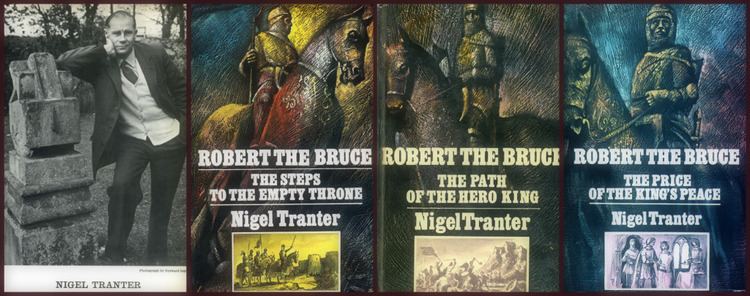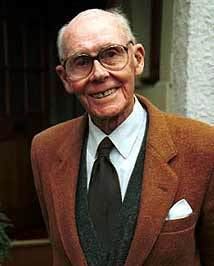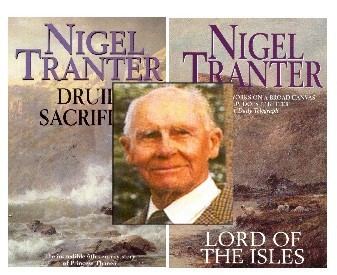Pen name Nye Tredgold Role Historian Occupation writer | Nationality Scottish Movies The Bridal Path Name Nigel Tranter | |
 | ||
Born 23 November 1909 ( 1909-11-23 ) Period 1935 – 2007 (published posthumously) Genre Historical fictionAdventureWesternsChildren's Subject Scottish historyArchitectureTravel (Scotland) Spouse May Jean Campbell Grieve (m. 1933–1979) Children Frances May, Philip Tranter Books The Bruce Trilogy, The Wallace, Macbeth the King, The Story of Scotland, A Folly of Princes | ||
Athelstaneford "Birthplace of Scotland's Flag"
Nigel Tranter OBE (23 November 1909 – 9 January 2000) was a Scottish author. He was a prolific author of architectural and history books about castles, and also of deeply researched historical novels that cover centuries of Scottish history.
Contents
- Athelstaneford Birthplace of Scotlands Flag
- Early life
- Writings
- The historian
- Public life
- Death
- Awards and honours
- References

Early life

Nigel Tranter was born in Glasgow and educated at George Heriot's School in Edinburgh. He trained as an accountant and worked in Scottish National Insurance Company, founded by his uncle. In 1933, he married May Jean Campbell Grieve and had two children, Frances May and Philip. He joined the Royal Artillery and served in East Anglia in the Second World War.
Writings
From childhood onwards, Tranter took a great interest in castles and their associated history. As a result, in 1935, at age 25, he published his first book, The Fortalices and Early Mansions of Southern Scotland. Encouraged by his wife, he wrote his first novel, In Our Arms Our Fortune, which was rejected by the publishers. However, Trespass soon followed and was accepted by The Moray Press. Unfortunately, they went bankrupt soon after its publication in 1937, and he didn't receive any payment. Over the next few years, he wrote several more novels in the same vein: light-hearted romantic adventures about imaginary characters. These had varied settings, from modern-day Europe to historical Scotland. Tranter also wrote several westerns under the pseudonym Nye Tredgold to provide additional income for his family, and a dozen children's books -adventure stories aimed at 8–10-year olds.
War service did not stop Tranter writing, and a number of novels were published during the war years, some inspired by his own experiences.
Between 1962 and 1971 Tranter published the landmark series The Fortified House in Scotland (in five volumes). This attempted to cover the history and structure of every primarily domestic castle in Scotland, 663 buildings in all. A small number of non-domestic buildings associated with priories, churches, communal defence etc. etc. were also included. Highly regarded at the time, it is still read by those who have an interest in this specialist area.
While researching the castles, Tranter realised that there were many characters and incidents in Scottish history which could be used as the basis for novels, which he tried to make as accurate as possible – while making no effort to hide his own strong Scottish identity. The Queen's Grace (1953) was his first novel to focus on an historical character (in this case, Mary, Queen of Scots), although it contained a high fictional content. Two trilogies followed: the MacGregor Trilogy (1957–1962) and the Master of Gray Trilogy (1961–1965). By this time, Tranter was well established as a writer of serious historical fiction. The fictional content decreased as he became more experienced, and his later novels were almost entirely composed around the historical record. These novels have gained a wide readership while providing a basic grounding in Scottish history to their readers.
The historian
As noted above, Tranter had a lifelong interest in Scottish castles. Initially intrigued by their architectural history, Tranter soon developed an interest in Scottish history generally. As he moved into historical novels, his research became deeper until he had amassed vast knowledge of Scotland's history to a very detailed level. His ability to retell history as a 'story' provided an accessible source for many people. As well as his novels, this knowledge was translated into such non-fiction works as The Story of Scotland. Becoming intimate with so much of the historical record, Tranter formed many theories of history, some of which were contrary to established thought. These were presented throughout his books. One example of this is his belief that the stone under the Coronation Chair is not the true Stone of Destiny, but a thirteenth-century fake which he refers to as the Westminster Stone.
Public life
Tranter was actively involved in affairs outside his writing. From the 1940s onwards he delivered lectures to private groups and organisations, and, as his writing career developed, he undertook many speaking engagements, including some tours to the USA. He was also invited to join—or was instrumental in setting up—many committees and community groups, in fields as diverse as Scottish Highlands roads and settlement, wild fowling and Athelstaneford's Flag Fund.
His notable involvements include: the original Scottish Convention, a cross-party pressure group established during the 1940s to encourage devolution (Edinburgh chairman); National Covenant Association; National Forth Road Bridge Committee; Saltire Society (honorary president).
Following the publication of The Fortified House in Scotland, Tranter was regularly asked for advice on the restoration of many tower houses and castles. He was closely involved in the restoration of over 60 castles, such as Fa'side Castle and Menstrie Castle.
Death
He died on 9 January 2000, aged 90, after contracting flu. His funeral and burial took place in Gullane.
